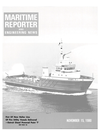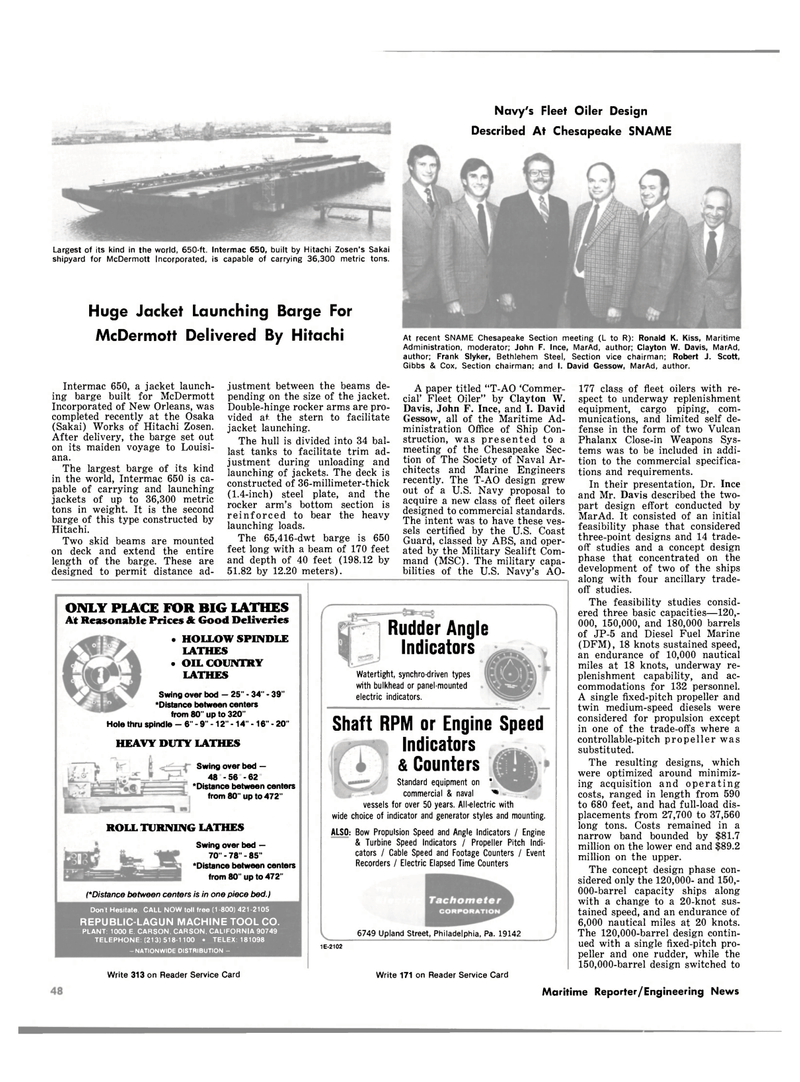
Page 48: of Maritime Reporter Magazine (November 15, 1980)
Read this page in Pdf, Flash or Html5 edition of November 15, 1980 Maritime Reporter Magazine
Navy's Fleet Oiler Design
Described At Chesapeake SNAME
At recent SNAME Chesapeake Section meeting (L to R): Ronald K. Kiss, Maritime
Administration, moderator; John F. Ince, MarAd, author; Clayton W. Davis, MarAd, author; Frank Slyker, Bethlehem Steel, Section vice chairman; Robert J. Scott,
Gibbs & Cox, Section chairman; and I. David Gessow, MarAd, author.
Huge Jacket Launching Barge For
McDermott Delivered By Hitachi
Largest of its kind in the world, 650-ft. Intermac 650, built by Hitachi Zosen's Sakai shipyard for McDermott Incorporated, is capable of carrying 36,300 metric tons.
Intermac 650, a jacket launch- ing barge built for McDermott
Incorporated of New Orleans, was completed recently at the Osaka (Sakai) Works of Hitachi Zosen.
After delivery, the barge set out on its maiden voyage to Louisi- ana.
The largest barge of its kind in the world, Intermac 650 is ca- pable of carrying and launching jackets of up to 36,300 metric tons in weight. It is the second barge of this type constructed by
Hitachi.
Two skid beams are mounted on deck and extend the entire length of the barge. These are designed to permit distance ad- justment between the beams de- pending on the size of the jacket.
Double-hinge rocker arms are pro- vided at. the stern to facilitate jacket launching.
The hull is divided into 34 bal- last tanks to facilitate trim ad- justment during unloading and launching of jackets. The deck is constructed of 36-millimeter-thick (1.4-inch) steel plate, and the rocker arm's bottom section is reinforced to bear the heavy launching loads.
The 65,416-dwt barge is 650 feet long with a beam of 170 feet and depth of 40 feet (198.12 by 51.82 by 12.20 meters).
A paper titled "T-AO 'Commer- cial' Fleet Oiler" by Clayton W.
Davis, John F. Ince, and I. David
Gessow, all of the Maritime Ad- ministration Office of Ship Con- struction, was presented to a meeting of the Chesapeake Sec- tion of The Society of Naval Ar- chitects and Marine Engineers recently. The T-AO design grew out of a U.S. Navy proposal to acquire a new class of fleet oilers designed to commercial standards.
The intent was to have these ves- sels certified by the U.S. Coast
Guard, classed by ABS, and oper- ated by the Military Sealift Com- mand (MSC). The military capa- bilities of the U.S. Navy's AO- 177 class of fleet oilers with re- spect to underway replenishment equipment, cargo piping, com- munications, and limited self de- fense in the form of two Vulcan
Phalanx Close-in Weapons Sys- tems was to be included in addi- tion to the commercial specifica- tions and requirements.
In their presentation, Dr. Ince and Mr. Davis described the two- part design effort conducted by
MarAd. It consisted of an initial feasibility phase that considered three-point designs and 14 trade- off studies and a concept design phase that concentrated on the development of two of the ships along with four ancillary trade- off studies.
The feasibility studies consid- ered three basic capacities—120,- 000, 150,000, and 180,000 barrels of JP-5 and Diesel Fuel Marine (DFM), 18 knots sustained speed, an endurance of 10,000 nautical miles at 18 knots, underway re- plenishment capability, and ac- commodations for 132 personnel.
A single fixed-pitch propeller and twin medium-speed diesels were considered for propulsion except in one of the trade-offs where a controllable-pitch propeller was substituted.
The resulting designs, which were optimized around minimiz- ing acquisition and operating costs, ranged in length from 590 to 680 feet, and had full-load dis- placements from 27,700 to 37,560 long tons. Costs remained in a narrow band bounded by $81.7 million on the lower end and $89.2 million on the upper.
The concept design phase con- sidered only the 120,000- and 150,- 000-barrel capacity ships along with a change to a 20-knot sus- tained speed, and an endurance of 6,000 nautical miles at 20 knots.
The 120,000-barrel design contin- ued with a single fixed-pitch pro- peller and one rudder, while the 150,000-barrel design switched to
ONLY PLACE FOR BIG LATHES
At Reasonable Prices & Good Deliveries • HOLLOW SPINDLE
LATHES • OIL COUNTRY
LATHES
Swing over bod - 25" - 34" - 39" 'Distance between centers from 80" up to 320"
Hole thru spindle - 6" - 9" -12" -14" -16" - 20"
HEAVY DUTY LATHES
Swing over bed — 48-56-62 'Distance between centers from 80" up to 472"
ROLL TURNING LATHES
Swing over bed — 70" - 78" - 85" 'Distance between centers from 80" up to 472" (*Distance between centers is in one piece bed.)
Don t Hesitate. CALL NOW toll free (1-800) 421-2105
REPUBLIC-LAGUN MACHINE TOOL CO.
PLANT: 1000 E. CARSON, CARSON, CALIFORNIA 90749
TELEPHONE: (213) 518-1100 • TELEX: 181098 -NATIONWIDE DISTRIBUTION -
Write 313 on Reader Service Card
Rudder Angle
Indicators
Watertight, synchro-driven types with bulkhead or panel-mounted electric indicators.
Shaft RPM or Engine Speed
Indicators & Counters
Standard equipment on ' commercial & naval : vessels for over 50 years. All-electric with wide choice of indicator and generator styles and mounting.
ALSO: Bow Propulsion Speed and Angle Indicators / Engine & Turbine Speed Indicators / Propeller Pitch Indi- cators / Cable Speed and Footage Counters / Event
Recorders / Electric Elapsed Time Counters 1E-2102 6749 Upland Street, Philadelphia, Pa. 19142
Write 171 on Reader Service Card 50
Maritime Reporter/Engineering News

 47
47

 49
49
